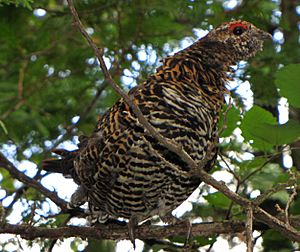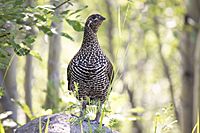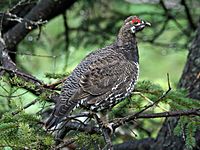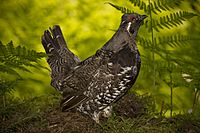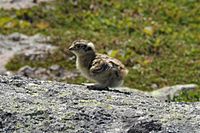Spruce grouse facts for kids
Quick facts for kids Spruce grouse |
|
|---|---|
 |
|
| Male of the nominate subspecies | |
 |
|
| Female | |
| Conservation status | |
| Scientific classification | |
| Genus: |
Falcipennis
|
| Species: |
canadensis
|
| Subspecies | |
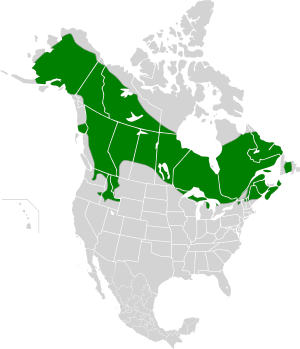 |
|
| Distribution map of the spruce grouse | |
| Synonyms | |
|
|
The spruce grouse (also called the Canada grouse) is a medium-sized bird found in North America. Its scientific name is Falcipennis canadensis. These birds love to live in the boreal forests (also known as taiga), which are forests full of cone-bearing trees like pine and spruce.
Spruce grouse are very good at living in trees. They can perch and move around easily in the branches. When a predator comes near, they often stay very still and rely on their camouflage to hide. They might even let people get very close before they finally fly away. Because of this behavior, they are sometimes called "fool's hen."
Contents
What Does a Spruce Grouse Look Like?
Spruce grouse are about 38 to 43 centimeters (15 to 17 inches) long. Males weigh around 550 to 650 grams (1.2 to 1.4 pounds), and females weigh 450 to 550 grams (1 to 1.2 pounds). Their wings can spread out about 54.5 to 57.5 centimeters (21.5 to 22.6 inches).
The way they look can be a bit different depending on where they live. But generally, adult males are mostly gray on top and black underneath. They have white spots along their sides. A special feature of the male is a bright red patch of bare skin above its eye, called an "eyebrow comb."
Adult females have mottled (spotty) brown or gray feathers. They have dark and white stripes on their undersides. Young spruce grouse look similar to the females.
It can be tricky to tell a female spruce grouse apart from a ruffed grouse. However, female spruce grouse have a dark tail with a light band at the end. Ruffed grouse have the opposite. Also, ruffed grouse raise their head feathers when they are scared, but spruce grouse do not.
Spruce Grouse Family Tree
For a long time, spruce grouse were thought to be two different species. Scientists later grouped them together. Now, they are known to be part of the Falcipennis genus, which also includes the Siberian grouse.
Currently, scientists recognize five main types (subspecies) of spruce grouse:
- F. c. osgoodi: Found in central Alaska and Canada's Northwest Territories.
- F. c. atratus: Lives along the coast of southwestern Alaska.
- F. c. canadensis: Found across Canada, from central Alberta to Labrador. Some were also brought to Newfoundland and Anticosti Island.
- F. c. canace: Lives in Maine and southern Canada, from Manitoba to Nova Scotia.
- F. c. torridus: Found in Nova Scotia.
Another type, Franklin's grouse (F. franklinii), which lives in British Columbia and the Rocky Mountains, was recently considered a separate species.
Where Spruce Grouse Live
Spruce grouse are specialists of the taiga (boreal forest). This means they are perfectly suited to live there. You can find them all over Canada. In the United States, they live in Alaska, northern New England, northern Michigan, northeastern Minnesota, northern Wisconsin, and the mountain forests of Montana, Idaho, Maine, Oregon, and Washington.
These birds always live in forests dominated by cone-bearing trees like pine, spruce, or fir. They seem to prefer younger forests that are growing back after a disturbance. In summer, they like areas with lots of blueberries and other shrubs. In winter, they prefer denser stands of trees.
What Do Spruce Grouse Eat?
In winter, the main food for spruce grouse is conifer needles. They clip these needles directly from the trees, especially from pine trees. Spruce needles are high in calcium, which is important for females when they are producing eggs in the spring.
In summer, these birds can look for food on the ground. They eat berries, green plants like blueberry leaves, fungi, and some insects.
When they only eat needles in winter, their bodies change to help them digest this tough food. Their caeca (parts of their intestines) and gizzard (a muscular stomach) get bigger. The crop, which is a pouch for storing food, is also very developed. It can hold a lot of needles, which they digest slowly overnight. Like other birds, spruce grouse eat clay, grit, or small stones. These help their gizzard grind up their food.
Young chicks, less than a week old, eat insects and other small creatures. Then they switch to berries and fungi until the fall. That's when they start eating needles like the adults.
Reproduction and Life Cycle
Male spruce grouse find and claim a territory. Females then visit these territories to mate. The female is responsible for raising the young on her own. However, sometimes males have been seen staying with young chicks, helping to keep the family group together.
For a nest, the female scratches a shallow dip in the ground. She usually places it under a bush, a low-hanging tree branch, or a fallen tree. She lines the nest with grasses, leaves, and a few feathers. She makes sure her nest is away from other females and male territories.
Nesting season is from early May to early July. A female can lay up to 10 eggs, but usually lays 4 to 7. She lays about one egg every 1.4 days. The eggs are about 40 millimeters (1.6 inches) long and are a brownish-yellow color with brown spots.
The female starts sitting on the eggs (incubation) after the last egg is laid. This lasts about 24 days. When they hatch, the chicks weigh about 15 grams (0.5 ounces). They are precocial, meaning they can walk out of the nest as soon as they are dry, which is about 8 hours after hatching. They can flutter up from the ground when they are just one week old.
The mother hen stays with her brood (group of chicks). She keeps them warm all night and often during the day until the chicks are 3 to 5 weeks old. The chicks make special calls when they are cold, which makes the mother brood them. When the chicks are 70 to 100 days old, they usually leave the group and become independent.
Females breed only once a year. Most females start breeding when they are one year old. About half of the males wait until they are two years old to claim a territory. Spruce grouse usually live for about 5 to 6 years in the wild. However, one study found some birds that lived to be at least 13 years old!
Sounds and Communication
Spruce grouse are known for being very quiet birds compared to other grouse. But they do make different sounds. They use calls to warn others about predators, to tell other grouse to stay out of their territory, to keep their family group together, or to get the mother to brood the chicks.
In one type of spruce grouse (franklinii), males have a special "wing-clap" display. After a short flight through the trees, they clap their wings together over their back. This makes two sharp claps, about half a second apart. These claps are loud enough for a person to hear from 150 meters (about 490 feet) away! Sometimes, if you clap your hands, a male might respond with his own wing-clap display. This helps scientists find male territories and count how many there are.
Other sounds they make don't involve their voice. Males can make a soft drumming sound by beating their wings. They also make a swishing or whooshing sound with their tail feathers when they fly.
How Spruce Grouse Move Around
Spruce grouse prefer to walk on the ground or along tree branches rather than fly. In the fall, like other grouse, they grow "snow shoes" on their toes. These are short extensions that grow on the sides of their toes. They make the toes wider, which helps the bird walk on snow and probably grip branches better. These "snow shoes" fall off in the spring.
Their flights are usually short, often just from the ground to a nearby tree, or from a tree to the ground. They can fly quickly, but no one has measured exactly how fast they go.
Spruce Grouse Travel
Spruce grouse usually stay in the same area their whole lives. They are considered permanent residents. However, some spruce grouse do move. In southwestern Alberta, up to 35% of females and 7% of males travel several kilometers (up to 11 km or about 7 miles) between their summer breeding spots and their winter homes. Similar movements have been seen in Alaska and New Brunswick, Canada.
Who Hunts Spruce Grouse?
Spruce grouse eggs can be eaten by animals like red squirrels, foxes, weasels, and birds like crows or jays. Adult spruce grouse can be hunted by various hawks and owls, foxes, pine martens, and coyotes.
Spruce Grouse and People
People often hunt spruce grouse. In the late 1970s, about 188,000 birds were hunted each year in the U.S., and about 360,000 in Canada. Even though the IUCN (International Union for Conservation of Nature) says the spruce grouse is of "Least Concern" (meaning it's not currently endangered), in many northern U.S. states, it is a protected species under hunting rules.
Gallery
See also
 In Spanish: Gallo canadiense para niños
In Spanish: Gallo canadiense para niños



